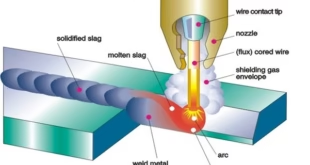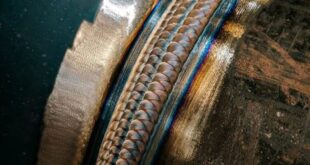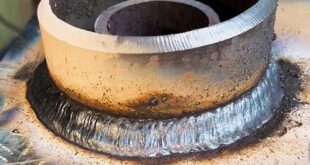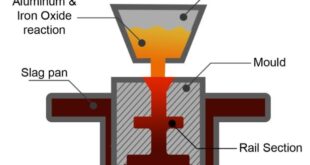Electric Resistance Welding
Introduction
Electric resistance welding (ERW) is a joining process that has become a popular and important method in the manufacturing industry. It is a type of non-fusion type of welding process. It involves the use of electric current to generate heat and pressure, which fuses two or more pieces of metal together. ERW has proven to be an efficient and cost-effective way to join metals, and it has numerous applications in various industries, including construction, automotive, aerospace, and electrical. In this article, we will explore the process of electric resistance welding, its applications, as well as the challenges and limitations of this method. We will also look at the future of electric resistance welding, including potential advancements and innovations that could further improve this technology.
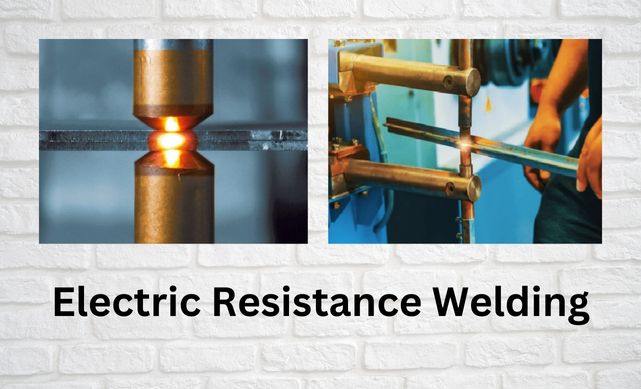
Process of Electric Resistance Welding
Electric resistance welding (ERW) is a process used to join metals through the application of heat and pressure. The process involves passing an electric current through the metals being welded, which generates heat and melts the edges of the materials to be joined. Here’s a more detailed breakdown of the process:
- Preparation: Before the welding process can begin, the edges of the materials to be joined must be properly prepared. This involves cleaning the surfaces to be welded and ensuring that they are free of any contaminants or impurities that could affect the quality of the weld. The edges are then brought into close proximity with each other, either by rolling or pressing the materials together.
- Application of current: An electric current is then passed through the materials being welded. The current generates heat, which causes the edges of the materials to melt and fuse together. The amount of current and the duration of the application depend on the materials being welded and the desired strength of the joint.
- Pressure application: Once the edges of the materials are molten, pressure is applied to the materials to complete the welding process. This pressure ensures that the melted edges of the materials are fused together completely, resulting in a strong and durable joint.
- Cooling and finishing: After the welding process is complete, the welded materials are allowed to cool before any finishing work is performed. This may involve grinding or polishing the surface of the joint to ensure that it is smooth and free of any defects or rough edges.
There are several different types of ERW, including spot welding, seam welding, and flash welding. The specific process used depends on the materials being welded and the desired strength and quality of the joint. Overall, electric resistance welding is a widely used and effective method for joining metals, and it offers several advantages over other welding techniques, including high production rates, low cost, and the ability to weld a wide range of materials.
Safety Consideration for ERW
Electric Resistance Welding (ERW) is a welding process that uses electricity to heat and join metals. As with any welding process, there are safety considerations that should be followed to ensure the safety of those performing the welding, as well as those nearby. Some important safety considerations for Electric Resistance Welding include:
- Proper PPE: Personal protective equipment (PPE) is essential for anyone performing Electric Resistance Welding. Welders should wear appropriate eye protection, welding gloves, and clothing that is flame-resistant.
- Adequate ventilation: Adequate ventilation is crucial when performing Electric Resistance Welding. Fumes and gases can be produced during the welding process, and these can be harmful if inhaled. The welding area should be well-ventilated, and welders should be provided with respiratory protection if necessary.
- Proper grounding: Proper grounding is essential to prevent electrical shock. The welding machine, workpiece, and welding operator should all be properly grounded.
- Training: Welders should be trained in the proper use of Electric Resistance Welding equipment and should follow all safety procedures. Inexperienced or untrained personnel should not be allowed to perform Electric Resistance Welding.
- Inspection and maintenance: Electric Resistance Welding equipment should be regularly inspected and maintained to ensure that it is in good working condition. Any equipment that is found to be defective or in need of repair should be taken out of service until it can be repaired or replaced.
- Fire safety: Electric Resistance Welding can create sparks and heat that can start fires. Welders should be trained in fire safety procedures and should have access to fire extinguishers and other fire-fighting equipment.
By following these safety considerations, Electric Resistance Welding can be performed safely and effectively, with a reduced risk of injury or other safety hazards.
Applications of Electric Resistance Welding
Electric resistance welding (ERW) is a versatile joining process used in various industries for its ability to create strong, reliable and cost-effective welded joints. Here are some of the applications of electric resistance welding:
- Automotive Industry: ERW is widely used in the automotive industry for joining various components such as exhaust systems, door frames, fuel lines, and brake lines. In particular, ERW is used in the production of mufflers, catalytic converters, and other exhaust system components, where it provides a leak-free and durable joint. ERW is also used to produce structural parts, such as frame rails and bumpers, which require high strength and durability.
- Construction Industry: ERW is used extensively in the construction industry for joining steel pipes and tubes for structural support and piping systems. ERW is preferred over other welding techniques due to its high production rates and low cost. It is commonly used in building construction, bridges, and other infrastructure projects.
- Electrical Industry: ERW is used in the electrical industry for manufacturing conduits and enclosures for electrical wiring. ERW can also be used to create various electrical components such as transformers, solenoids, and coils. ERW is preferred over other welding techniques for the electrical industry because it provides a clean and uniform weld.
- Furniture Industry: ERW is used in the furniture industry for joining tubular metal frames for chairs, tables, and other pieces of furniture. ERW is preferred over other welding techniques because it creates strong and uniform welds without damaging the surface of the material being welded.
- Aerospace Industry: ERW is used in the aerospace industry for joining various components such as aircraft fuel lines, hydraulic tubing, and electrical conduits. ERW is preferred over other welding techniques because it provides a strong and leak-free joint while maintaining the structural integrity of the welded material.
- Agriculture Industry: ERW is used in the agriculture industry for joining various components such as fencing, gates, and other equipment. ERW is preferred over other welding techniques because it is fast, cost-effective and creates a strong and durable joint.
- Oil and Gas Industry: ERW is used in the oil and gas industry for joining pipelines, and casings. ERW provides a reliable, cost-effective, and high-speed method for creating welded joints in pipelines, which are required for transporting oil and gas.
In conclusion, electric resistance welding is a versatile and cost-effective joining process that is widely used in various industries for creating strong and reliable welded joints. The wide range of applications of ERW shows its effectiveness in creating high-quality welds in various industries, and it is expected to continue being a popular choice for joining metals in the future.
Challenges and Limitations of Electric Resistance Welding
Electric resistance welding (ERW) is a versatile welding technique that offers several advantages, such as high productivity, low distortion, and good control over the welding process. However, like any other welding technique, ERW also has its limitations and challenges that can affect its efficiency and effectiveness. Here are some of the challenges and limitations of electric resistance welding:
Material Selection
ERW is most suitable for joining low-carbon steel materials. Other materials such as high-strength alloys and stainless steels can be welded using ERW, but they require careful process control and special equipment. This limitation in material selection can restrict the application of ERW in certain industries.
Weld Strength
ERW produces welds that are strong and durable, but the strength of the weld is dependent on the quality of the joint. Poor joint quality can lead to weaker welds that may not meet the required standards.
Joint Preparation
ERW requires precise joint preparation to ensure a successful weld. Any contamination, oxidation, or improper joint alignment can lead to an incomplete weld, resulting in poor quality joints.
Weld Quality Control
Monitoring and controlling the welding process is crucial to ensure consistent and high-quality welds. Any fluctuation in process parameters such as current, voltage, or electrode pressure can lead to poor quality welds.
Equipment Maintenance
ERW machines require regular maintenance and calibration to ensure proper function and accuracy. Failure to maintain the equipment can lead to poor-quality welds, increased downtime, and higher costs.
Limitations in Weld Geometry
ERW is suitable for joining cylindrical or tubular materials, and welding flat plates is limited by the size of the electrode used. This limitation in weld geometry can restrict the application of ERW in certain industries.
Future of Electric Resistance Welding
Electric resistance welding (ERW) is a widely used technique for joining metals in various industries such as automotive, aerospace, construction, and electrical. With the advancements in technology, ERW is likely to see further improvements and wider applications in the future.
Advancements in welding technology
One of the main areas of improvement in ERW is the development of more advanced welding technology. This includes the use of automated and robotic welding systems that can improve the speed, precision, and quality of the welds. The robots are designed to perform the welding process in a controlled environment, minimizing the operator’s exposure to heat, radiation, and toxic fumes. Moreover, robots can work non-stop, reducing the need for manual labor, and increasing productivity.
The advanced monitoring and control systems will enable welders to measure and monitor the weld’s parameters in real-time, making the process more efficient and accurate. These systems will allow welders to adjust the welding parameters based on the material, thickness, and other factors, ensuring consistent weld quality.
The improved power sources and welding transformers will help increase the energy efficiency of the welding process, reducing the costs of production, and environmental impact. The innovations in electrode design will also contribute to more efficient and durable electrodes, reducing the frequency of replacement and increasing the lifespan of the equipment.
The developments in materials science, such as new high-strength and corrosion-resistant alloys, will also create new opportunities for the use of ERW in the manufacturing industry. This will allow for more advanced and complex designs that require high precision and superior welding quality.
Integration with other technologies
ERW is likely to become more integrated with other technologies such as additive manufacturing, 3D printing, and smart manufacturing. This will allow manufacturers to create complex components with intricate designs, while still maintaining the high-quality welds necessary for structural integrity. The combination of these technologies will result in more efficient and cost-effective production processes, reducing the time and costs associated with manual labor.
Moreover, the integration of smart manufacturing technologies such as the Internet of Things (IoT) will enable manufacturers to collect and analyze data from sensors and other devices in real-time, optimizing the welding process, and improving the overall quality of the final product.
In conclusion, the future of electric resistance welding is bright with the advancements in welding technology and the integration of other technologies, opening up new opportunities for the use of ERW in various industries. The improvements in automation, monitoring, control, and material science will allow for faster, more efficient, and more precise welding, while the integration of smart manufacturing technologies will lead to more cost-effective and environmentally friendly production processes.
FAQs
What is meant by electric resistance welding?
Electric resistance welding (ERW) is a welding technique where the heat needed to join two materials is generated by the electrical resistance of the materials themselves, with no external heating source required. ERW is commonly used for welding metals such as steel, stainless steel, and aluminum.
What are two types of electric resistance welding?
The two main types of electric resistance welding are:
Spot welding: A type of resistance welding where two or more metal sheets are joined by applying pressure and heat to a small area, using two electrodes.
Seam welding: A type of resistance welding where two or more metal sheets are joined by continuously welding along a seam, using a wheel-shaped electrode.
What is the difference between ERW and EFW pipe?
ERW and Electric Fusion Welding (EFW) are two different welding techniques. ERW uses the resistance of the metal to generate heat, whereas EFW uses a combination of heat and pressure to fuse the materials together. EFW is commonly used for welding pipes and tubes, while ERW is used for various applications, including pipes and tubes, sheet metal, and wire.
What is the use of electric resistance seam welding?
Electric resistance seam welding (ERSW) is a type of seam welding where a wheel-shaped electrode rotates and applies pressure and heat along the seam of two or more metal sheets. ERSW is commonly used for welding tubes and pipes, as well as for other applications where a continuous weld is needed.
What is electrical resistance example?
Electrical resistance is a measure of how difficult it is for an electric current to flow through a material. An example of electrical resistance is the resistance of a light bulb filament, which converts the electrical energy into light and heat.
Is resistance welding AC or DC?
Resistance welding can be done using both AC (alternating current) and DC (direct current) power sources, depending on the material being welded and the welding conditions.
What is electrical resistance called?
Electrical resistance is also called “resistivity” or “impedance”.
What electrode is used in resistance welding?
In resistance welding, various types of electrodes can be used, depending on the application. For example, spot welding typically uses electrodes made of copper, brass, or tungsten, while seam welding uses wheel-shaped electrodes made of materials such as copper, steel, or aluminum.
Conclusion
In conclusion, electric resistance welding (ERW) is a versatile welding technique that offers many advantages, including high productivity, low distortion, and good control over the welding process. ERW has found applications in various industries, such as automotive, aerospace, construction, and energy, and it is widely used to join low-carbon steel materials. However, like any other welding technique, ERW has its limitations and challenges, such as material selection, weld strength, joint preparation, weld quality control, equipment maintenance, and limitations in weld geometry. These challenges can affect the efficiency and effectiveness of ERW, and they should be considered when selecting it for a particular application. Nevertheless, with proper equipment maintenance, weld quality control, and joint preparation, these challenges can be overcome, and ERW can continue to be a valuable welding technique for various industries in the future.
 Welding of Welders All about Welding and Welders
Welding of Welders All about Welding and Welders
